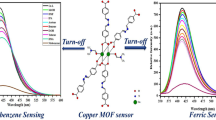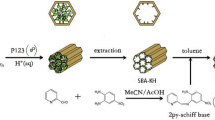Abstract
Seminaphthorhodafluor (SNARF) Schiff base (SNARF-SB) bridged periodic mesoporous organosilicas (SSPMOs) with “turn-on” fluorescence enhancement for sensing Cu2+ were synthesized via a template-directed co-condensation method. Small-angle x-ray scattering (SAXS) patterns, high resolution transmission electron microscope (HRTEM) images, and N2 adsorption–desorption isotherms indicated the presence of mesoporous structure in the SSPMOs. FT-IR spectra and 29Si MAS NMR data confirmed the successful incorporation of bridged organic groups in the framework of SSPMOs. The luminous properties that SSPMOs had a selective response to Cu2+ were investigated by UV–Vis absorption spectroscopy and fluorescence spectroscopy. The limit of detection (LOD) was 5.1 × 10–7 M and binding stoichiometry was determined 1:1 between SNARF-SB and Cu2+. The fluorescence enhancement of SSPMOs towards Cu2+ was induced by ring-opening of the spirolactam in SNARF-SB in framework of SSPMOs, which was confirmed by FT-IR spectra of SNARF-SB with Cu2+. Moreover, SSPMOs have improved fluorescence lifetimes compared with that of SNARF-SB. Therefore, SSPMOs can be a progressive chemical sensor for Cu2+ due to its high selectivity, recyclability, and stability.

















Similar content being viewed by others
Data Availability
The datasets generated during the current study are available from the corresponding author on reasonable request.
References
Wu D, Sedgwick AC, Gunnlaugsson T, Akkaya EU, Yoon J, James TD (2017) Fluorescent chemosensors: the past, present and future. Chem Soc Rev 46:7105–7123. https://doi.org/10.1039/c7cs00240h
AbhijnaKrishna R, Velmathi S (2022) A review on fluorimetric and colorimetric detection of metal ions by chemodosimetric approach 2013–2021. Coord Chem Rev. https://doi.org/10.1016/j.ccr.2021.214401
Capon PK, Li J, Horsfall AJ, Yagoub S, Schartner EP, Khalid A, Kirk RW, Purdey MS, Dunning KR, McLaughlin RA, Abell AD (2021) A Silk-Based Functionalization Architecture for Single Fiber Imaging and Sensing. Adv Funct Mater. https://doi.org/10.1002/adfm.202010713
Wei D, Engelman DM, Reshetnyak YK, Andreev OA (2019) Mapping pH at Cancer Cell Surfaces. Mol Imaging Biol 21:1020–1025. https://doi.org/10.1007/s11307-019-01335-4
Destino JF, Craft AK, Bright FV (2017) Three-Dimensional pH Mapping within Model Hybrid Xerogel Thin Films. Langmuir 33:4119–4128. https://doi.org/10.1021/acs.langmuir.6b04518
Kuhana AT, Feng W, Feng G (2018) A simple but effective colorimetric and far-red to near-infrared fluorescent probe for palladium and its application in living cells. Dyes Pigm 152:112–117. https://doi.org/10.1016/j.dyepig.2018.01.044
Jin X, Zhao S, Wang T, Si L, Liu Y, Zhao C, Zhou H, Leng X, Zhang X (2019) Near-infrared fluorescent probe for selective detection of H2S and its application in living animals. Anal Bioanal Chem 411:5985–5992. https://doi.org/10.1007/s00216-019-01973-1
Duan Q, Zhu H, Liu C, Yuan R, Fang Z, Wang Z, Jia P, Li Z, Sheng W, Zhu B (2019) A carbonothioate-based far-red fluorescent probe for the specific detection of mercury ions in living cells and zebrafish. Analyst 144:1426–1432. https://doi.org/10.1039/c8an01696h
Zeng X, Gao S, Jiang C, Jin X, Ma M, Liu Z, Chen J (2021) A Colorimetric and Long-Wavelength “Turn-On” Fluorescent Probe for Copper Ions Detection with High Selectivity and Sensitivity. ChemistrySelect 6:6619–6624. https://doi.org/10.1002/slct.202101520
Jia X, Li X, Geng X, Nie C, Zhang P, Wei C, Li X (2019) A seminaphthorhodafluor-based near-infrared fluorescent probe for hydrazine and its bioimaging in living systems. Spectrochim Acta A Mol Biomol Spectrosc 223:117307. https://doi.org/10.1016/j.saa.2019.117307
Zhu H, Liu C, Yuan R, Wang R, Zhang H, Li Z, Jia P, Zhu B, Sheng W (2019) A simple highly specific fluorescent probe for simultaneous discrimination of cysteine/homocysteine and glutathione/hydrogen sulfide in living cells and zebrafish using two separated fluorescence channels under single wavelength excitation. Analyst 144:4258–4265. https://doi.org/10.1039/c9an00818g
Li H, Shen D, Lu H, Wu F, Chen X, Pleixats R, Pan J (2021) The synthetic approaches, properties, classification and heavy metal adsorption applications of periodic mesoporous organosilicas. Sep Purif Technol. https://doi.org/10.1016/j.seppur.2021.119453
Karimi B, Ganji N, Pourshiani O, Thiel WR (2022) Periodic mesoporous organosilicas (PMOs): From synthesis strategies to applications. Prog Mater Sci. https://doi.org/10.1016/j.pmatsci.2021.100896
Gao M, Xing C, Jiang X, Xu L, Li P, Hsiao CD (2021) Highly selective fluorescence detection of Cu2+ based on Schiff base functionalized periodic mesoporous organosilicas. Luminescence 36:951–957. https://doi.org/10.1002/bio.4021
Hao X, Han S, Zhu J, Hu Y, Chang LY, Pao CW, Chen JL, Chen JM, Haw SC (2019) A bis-benzimidazole PMO ratiometric fluorescence sensor exhibiting AIEE and ESIPT for sensitive detection of Cu2+. RSC Adv 9:13567–13575. https://doi.org/10.1039/c9ra00892f
Zhou A, Han S (2021) An “off-on-off” fluorescence chemosensor for the sensitive detection of Cu2+ in aqueous solution based on multiple fluorescence emission mechanisms. Analyst 146:2670–2678. https://doi.org/10.1039/d0an02472d
Li H, Li Y, Zhang Z, Pang X, Yu X (2019) Highly selective luminescent sensing of Cu2+ in aqueous solution based on a Eu(III)-centered periodic mesoporous organosilicas hybrid. Mater Des. https://doi.org/10.1016/j.matdes.2019.107712
Liu W, Kaczmarek AM, Rijckaert H, Van Der Voort P, Van Deun R (2021) Chemical sensors based on a Eu(iii)-centered periodic mesoporous organosilica hybrid material using picolinic acid as an efficient secondary ligand. Dalton Trans 50:11061–11070. https://doi.org/10.1039/d1dt01767e
Jiao X, Liu C, Huang K, Zhang S, He S, Zhao L, Zeng X (2015) Molecular design and synthesis of a pH independent and cell permeant fluorescent dye and its applications. Org Biomol Chem 13:6647–6653. https://doi.org/10.1039/c5ob00448a
Mondal S, Manna SK, Pathak S, Ghosh A, Datta P, Mandal D, Mukhopadhyay S (2020) A “turn-on” fluorescent and colorimetric chemodosimeter for selective detection of Au3+ ions in solution and in live cells via Au3+-induced hydrolysis of a rhodamine-derived Schiff base. New J Chem 44:7954–7961. https://doi.org/10.1039/d0nj01273d
Jiang D, Yang Q, Wang H, Zhu G, Yang J, Li C (2006) Periodic mesoporous organosilicas with trans-(1R,2R)-diaminocyclohexane in the framework: A potential catalytic material for asymmetric reactions. J Catal 239:65–73. https://doi.org/10.1016/j.jcat.2006.01.018
Pereira C, Alves C, Monteiro A, Magen C, Pereira AM, Ibarra A, Ibarra MR, Tavares PB, Araujo JP, Blanco G, Pintado JM, Carvalho AP, Pires J, Pereira MF, Freire C (2011) Designing novel hybrid materials by one-pot co-condensation: from hydrophobic mesoporous silica nanoparticles to superamphiphobic cotton textiles. ACS Appl Mater Interfaces 3:2289–2299. https://doi.org/10.1021/am200220x
Tang R, Lei K, Chen K, Zhao H, Chen J (2011) A rhodamine-based off-on fluorescent chemosensor for selectively sensing Cu(II) in aqueous solution. J Fluoresc 21:141–148. https://doi.org/10.1007/s10895-010-0698-x
Muthusamy S, Rajalakshmi K, Kannan P, Zhu D, Seo Y, Zhu W, Song J-W, Lee K-B, Nam Y-S (2022) Targeting citrate as novel strategy in diagnosing prostate cancer using Rhodamine extended red emissive fluorophore: Sensing mechanism and prostate tumor diagnosis applications. Sens Actuators B. https://doi.org/10.1016/j.snb.2022.132299
Huang K, Liu Y, Li Q, Yu B, Liang L, Qin D (2022) A quinoline-rhodamine hybrid probe for ratiometricly sensing of Hg2+ in water and cell imaging application. Spectrochim Acta A Mol Biomol Spectrosc 281:121651. https://doi.org/10.1016/j.saa.2022.121651
Acknowledgements
All authors are very grateful for the support of Center for Structural and Property Analysis of Shandong University.
Funding
No funding was received for the manuscript.
Author information
Authors and Affiliations
Contributions
Yangyang Ren designed the research, carried out experiments and wrote the main manuscript. Shuhua Han designed the research, supervised the findings of the research and reviewed the manuscript. All authors made contribution to the final manuscript.
Corresponding author
Ethics declarations
Ethics Approval
Not applicable.
Consent to Participate
Not applicable.
Consent for Publication
Not applicable.
Conflicts of Interest
The authors have no competing interests to declare that are relevant to the manuscript.
Additional information
Publisher's Note
Springer Nature remains neutral with regard to jurisdictional claims in published maps and institutional affiliations.
Electronic Supplementary Material
Below is the link to the electronic supplementary material.
Appendix A
Appendix A
Supporting Information
More spectroscopic data can be found in Supporting Information.
Rights and permissions
Springer Nature or its licensor (e.g. a society or other partner) holds exclusive rights to this article under a publishing agreement with the author(s) or other rightsholder(s); author self-archiving of the accepted manuscript version of this article is solely governed by the terms of such publishing agreement and applicable law.
About this article
Cite this article
Ren, Y., Han, S. Seminaphthorhodafluor Derivatives Bridged Periodic Mesoporous Organosilicas for Detection of Cu2+. J Fluoresc 33, 327–337 (2023). https://doi.org/10.1007/s10895-022-03059-1
Received:
Accepted:
Published:
Issue Date:
DOI: https://doi.org/10.1007/s10895-022-03059-1




